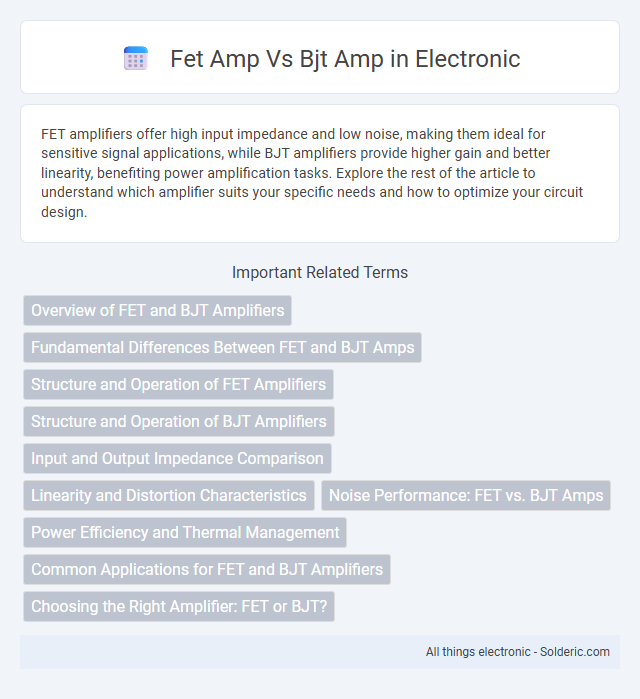FET amplifiers offer high input impedance and low noise, making them ideal for sensitive signal applications, while BJT amplifiers provide higher gain and better linearity, benefiting power amplification tasks. Explore the rest of the article to understand which amplifier suits your specific needs and how to optimize your circuit design.
Comparison Table
| Feature | FET Amplifier | BJT Amplifier |
|---|---|---|
| Transistor Type | Field Effect Transistor (FET) | Bipolar Junction Transistor (BJT) |
| Input Impedance | High (typically megaohms) | Low to moderate (kiloohms) |
| Output Impedance | Moderate to high | Low to moderate |
| Current Gain (b) | Low (close to 1) | High (typically 20-1000) |
| Voltage Gain | Moderate | High |
| Noise Level | Lower noise, suitable for high-frequency applications | Higher noise compared to FETs |
| Thermal Stability | Better thermal stability | Less thermal stability, prone to thermal runaway |
| Power Consumption | Lower quiescent current | Higher quiescent current |
| Linearity | Good linearity | Excellent linearity |
| Applications | Low-noise amplifiers, RF circuits, impedance buffering | Audio amplifiers, switching circuits, power amplification |
Overview of FET and BJT Amplifiers
Field-Effect Transistor (FET) amplifiers operate by controlling voltage to regulate current flow, offering high input impedance and low noise, making them ideal for voltage amplification. Bipolar Junction Transistor (BJT) amplifiers function through current control, providing high gain and better linearity suitable for applications requiring strong signal amplification. Both FET and BJT amplifiers serve critical roles in analog circuits, with FETs preferred for low-noise environments and BJTs favored for high-gain scenarios.
Fundamental Differences Between FET and BJT Amps
FET amplifiers operate using voltage-controlled channels, offering high input impedance and low noise, making them ideal for sensitive signal amplification. BJT amplifiers rely on current-controlled junctions, providing higher gain and faster switching speeds but lower input impedance compared to FETs. The fundamental difference lies in their control mechanism: FETs use an electric field to modulate conductivity, while BJTs depend on charge carrier injection.
Structure and Operation of FET Amplifiers
Field-Effect Transistor (FET) amplifiers leverage a voltage-controlled channel to regulate current flow, enabling high input impedance and low noise performance. In contrast to Bipolar Junction Transistor (BJT) amplifiers that rely on current control through junctions, FETs use an electric field to modulate conductivity within a semiconductor channel. Your design benefits from FET amplifiers in applications requiring minimal input loading and efficient operation at high frequencies.
Structure and Operation of BJT Amplifiers
BJT amplifiers utilize a bipolar junction transistor structure with three regions: emitter, base, and collector, enabling current control through the injection and recombination of charge carriers. The operation relies on the transistor's ability to amplify current by controlling the base current, which modulates a larger current flowing from collector to emitter. Your choice of BJT amplifier benefits from high gain and linear amplification due to this charge carrier dynamic within the layered semiconductor structure.
Input and Output Impedance Comparison
FET amplifiers typically exhibit high input impedance, often in the megaohm range, which minimizes signal loading and preserves source integrity, whereas BJT amplifiers generally have lower input impedance, usually in the kiloohm range. Output impedance in FET amplifiers tends to be moderately high, requiring buffer stages for driving low-impedance loads, while BJT amplifiers offer lower output impedance, enabling better current driving capability. These impedance characteristics influence amplifier selection based on the specific requirements for signal fidelity and load matching in audio, RF, and analog circuit designs.
Linearity and Distortion Characteristics
FET amplifiers typically offer higher linearity and lower distortion compared to BJT amplifiers due to their voltage-controlled operation and high input impedance, which reduces non-linearities in signal amplification. BJTs, being current-controlled devices, often introduce more distortion, especially at higher signal levels due to their exponential I-V characteristics. Your choice between FET and BJT amplifiers will impact the overall fidelity and accuracy of analog signal processing, especially in low-noise and high-frequency applications.
Noise Performance: FET vs. BJT Amps
FET amplifiers exhibit lower noise levels at high frequencies due to their high input impedance and reduced thermal noise, making them ideal for sensitive signal applications. BJT amplifiers generally present higher noise currents but can perform better at low frequencies with lower voltage noise contributions. Your choice depends on whether minimizing voltage noise or current noise is more critical for your specific amplification needs.
Power Efficiency and Thermal Management
FET amplifiers generally offer higher power efficiency than BJT amplifiers due to their lower gate current and better switching characteristics, reducing energy loss and heat generation. Thermal management in FET amps is simpler as these devices tend to produce less heat under equivalent power conditions, enhancing reliability and longevity. Your choice of amplifier impacts overall system performance, with FET amps providing improved energy savings and reduced cooling requirements.
Common Applications for FET and BJT Amplifiers
FET amplifiers excel in high-impedance input applications such as RF receivers, impedance buffering, and low-noise amplification due to their superior gate input characteristics and low noise figure. BJT amplifiers are commonly used in audio amplification, high-gain stages, and power amplification where high current drive and linearity are critical. Your choice between FET and BJT amplifiers hinges on the specific application requirements, balancing factors like input impedance, noise performance, and power handling.
Choosing the Right Amplifier: FET or BJT?
Choosing between a FET amplifier and a BJT amplifier depends on your specific application requirements, such as input impedance, thermal stability, and linearity. FETs generally offer higher input impedance and lower noise, making them ideal for sensitive signal amplification, while BJTs provide higher gain and better current handling capabilities. Understanding these key differences ensures you select the right amplifier type to optimize performance and reliability in your circuit design.
fet amp vs bjt amp Infographic

 solderic.com
solderic.com